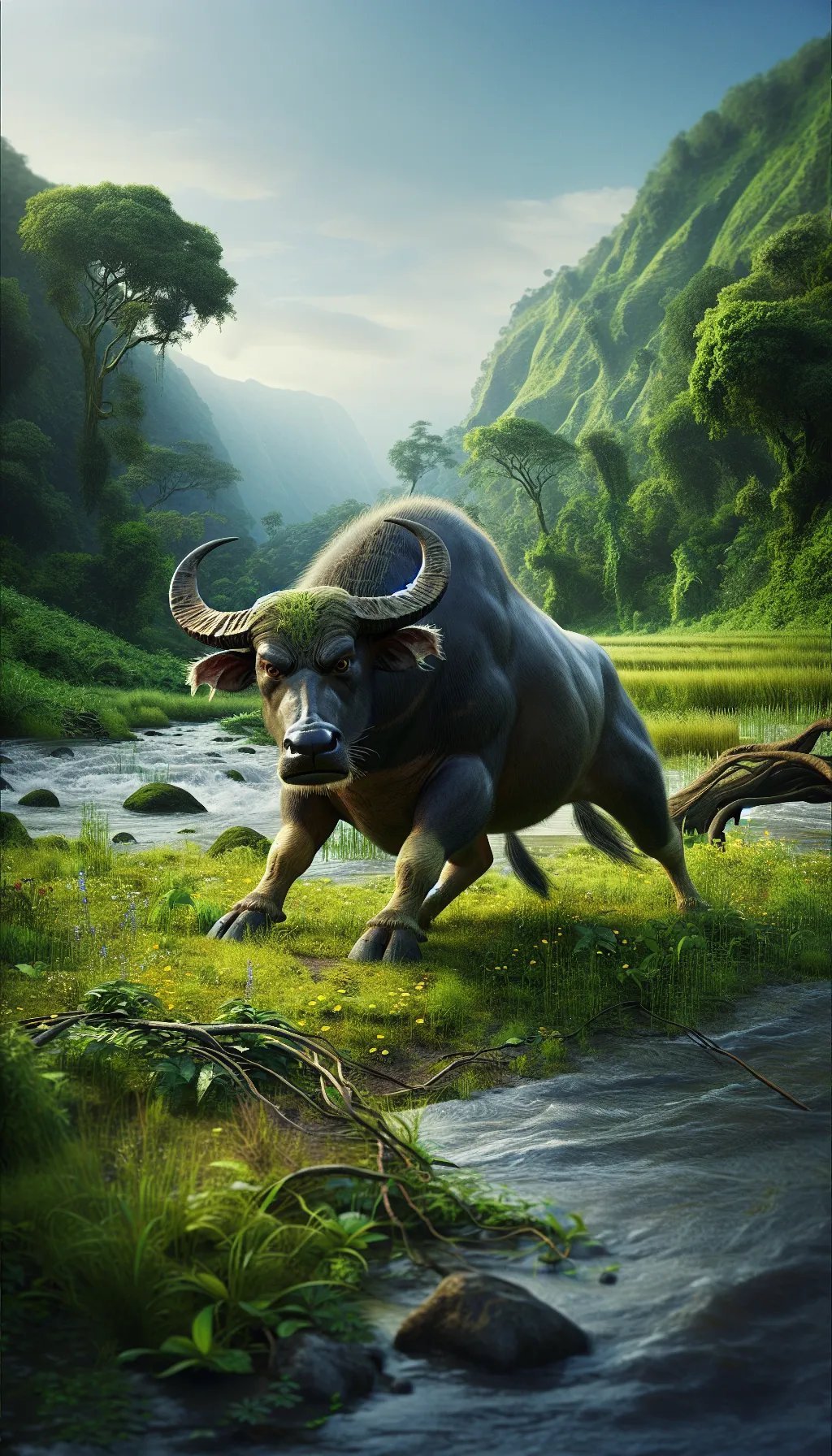The Wild Water Buffalo
The Wild Water Buffalo, also known as the Asiatic buffalo or Arni, is a large bovine species native to Southeast Asia. These majestic creatures are the largest wild bovids in the world, with males reaching lengths up to 3 meters and weighing around 1,200 kilograms. They feature a distinctive and robust build, with a thick-set body, powerful limbs, and long, curving horns. Their dark gray or black coarse hair covers their body, and they have a comparatively large head with a wide face and a pronounced ridge along the forehead. Wild Water Buffalos are primarily herbivorous and inhabit marshy grasslands, swamps, and river valleys, where they form social groups led by dominant males called bulls.

| Wild Water Buffalo | |
|---|---|
| Size | Up to 1.9 meters (6.2 feet) tall at the shoulder; up to 3 meters (9.8 feet) in length |
| Weight | Up to 1,200 kilograms (2,600 pounds) |
| Speed | 30mph (48km/h) |
| Key Strength | Size and muscular build |
| Biggest Weakness | None specified |
| Scientific Name | Bubalus arnee |
| Family | Bovidae |
| Habitat | Wetlands, marshes, grasslands |
| Geography | Indian subcontinent, Southeast Asia |
| Diet | Herbivorous |
| Lifespan | 10 years - 25 years |

The Wild Water Buffalo
The Wild Water Buffalo, also known as the Asiatic buffalo or Arni, is a large bovine species native to Southeast Asia. These majestic creatures are the largest wild bovids in the world, with males reaching lengths up to 3 meters and weighing around 1,200 kilograms. They feature a distinctive and robust build, with a thick-set body, powerful limbs, and long, curving horns. Their dark gray or black coarse hair covers their body, and they have a comparatively large head with a wide face and a pronounced ridge along the forehead. Wild Water Buffalos are primarily herbivorous and inhabit marshy grasslands, swamps, and river valleys, where they form social groups led by dominant males called bulls.
Fun Fact: Despite their massive size, Wild Water Buffalos are surprisingly skilled swimmers, effortlessly crossing rivers, even against fast currents, using their strong legs to propel themselves forward and their heads held high above the water.
| Wild Water Buffalo | |
|---|---|
| Size | Up to 1.9 meters (6.2 feet) tall at the shoulder; up to 3 meters (9.8 feet) in length |
| Weight | Up to 1,200 kilograms (2,600 pounds) |
| Speed | 30mph (48km/h) |
| Key Strength | Size and muscular build |
| Biggest Weakness | None specified |
| Scientific Name | Bubalus arnee |
| Family | Bovidae |
| Habitat | Wetlands, marshes, grasslands |
| Geography | Indian subcontinent, Southeast Asia |
| Diet | Herbivorous |
| Lifespan | 10 years - 25 years |
Wild Water Buffalo Matchups
We use AI to simulate matchups between the Wild Water Buffalo and other animals. Our simulation considers size, strength, and natural predatory behaviors to determine the most likely outcome.
Wild Water Buffalo: Diet, Predators, Aggression, and Defensive Behaviors
What do Wild Water Buffalos eat?
Wild Water Buffalos are herbivores and primarily graze on grasses, aquatic plants, and leaves. Wild Water Buffalo also eat fruits and crops, making them opportunistic feeders. Their diet is high in fiber, and Wild Water Buffalo spend a significant amount of time foraging to meet their nutritional needs.
Do Wild Water Buffalos have any predators?
Adult Wild Water Buffalos are large and powerful animals, making them less vulnerable to predation. However, Wild Water Buffalo may be targeted by large carnivores such as tigers, crocodiles, and dholes (wild dogs). Calves are more at risk, and predators will often target them when Wild Water Buffalo are separated from the herd.
Are Wild Water Buffalos aggressive?
Wild Water Buffalos can be aggressive, especially during the mating season or when protecting their young. Wild Water Buffalo are known to charge at perceived threats, including humans, and can be particularly dangerous when wounded or cornered. It's essential to give these animals space and not provoke them.
Do Wild Water Buffalos fight?
Male Wild Water Buffalos, known as bulls, often engage in fierce battles during the breeding season to establish dominance and mating rights. These fights can be intense and involve headbutting, pushing, and locking horns. The clashes can result in injuries, and the winner earns the right to mate with females in the herd.
How do Wild Water Buffalos defend themselves?
Wild Water Buffalos have several defense mechanisms to protect themselves from predators and threats. Wild Water Buffalo have strong, curved horns that Wild Water Buffalo use for defense and to establish dominance within their herd. Wild Water Buffalo also have a thick, tough hide that provides protection against bites and scratches. When faced with danger, Wild Water Buffalo will often form a defensive circle with their young in the center, using their horns to ward off attackers.
What is the Wild Water Buffalo's biggest weakness in a fight?
Despite their formidable size and strength, Wild Water Buffalos have a vulnerable spot in their fight against predators or rivals – their flanks. Their horns are useful for head-on confrontations, but their sides are more exposed and less protected. Predators such as tigers often target the flanks of buffalos to bring them down during an attack. Buffalos must be vigilant and aware of threats from all sides to defend themselves effectively.
Fun Fact: The Wild Water Buffalo plays a crucial role in its ecosystem, as it creates trails and water holes while wallowing in the mud, benefiting other species by providing access to water, minimizing soil erosion, and aiding in the dispersion of seeds through its dung.
Fun Fact: These amazing creatures have an excellent memory, being able to remember familiar pathways and water sources, which allows them to navigate through their extensive home ranges, even in challenging environments with dense vegetation.
















